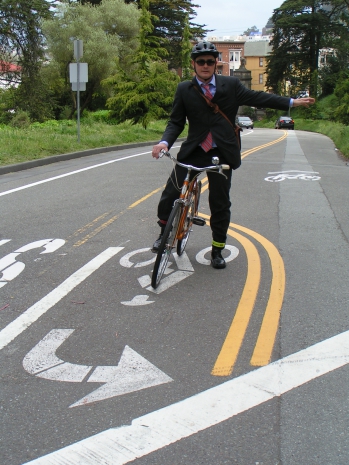
© California Bicycle Coalition 2025

1017 L Street #288
Sacramento, CA 95814
© California Bicycle Coalition 2025
Last week, the Complete Streets Bill, SB 960, passed the Assembly Transportation Committee by a wide margin (11-4). As Streetsblog correctly pointed out, the bill exited the committee weaker than it entered it, but CalBike still supports the measure, and we remain optimistic that its passage will spur Caltrans to do a better job providing infrastructure for people biking and walking.
The good news is that Caltrans has stepped forward to offer amendments to the Complete Streets Bill. Reaching an agreement with Caltrans means the agency is less likely to oppose the final bill if it makes it to the governor’s desk. The last time Senator Scott Wiener introduced a Complete Streets Bill, SB 127, in 2019, the bill passed the legislature, but Governor Gavin Newsom vetoed it, so getting Caltrans’ (and CalSTA’s) approval could make the difference between passing and failing.
Unsurprisingly, the Caltrans amendments weaken provisions in SB 960, making it easier for the agency to find reasons not to include elements that improve safety for people biking, walking, or taking public transportation in its repaving projects. Critically, the changes would allow Caltrans to continue citing budget limitations as a reason to exclude Complete Streets from the project scope. However, SB 960 increases scrutiny and accountability of Caltrans’ decision-making process and will pull back the bureaucratic curtain that the agency uses to the detriment of people biking and walking in their communities.
CalBike wants more State Highway Operation and Protection Program (SHOPP) dollars (our state highway maintenance program) to go to active transportation infrastructure, moving us away from our car-dominated transportation system. We will keep moving further from Vision Zero as long as Caltrans corridors prioritize fast-moving motor vehicles without providing complete sidewalks and crosswalks, protected bike lanes, and safe bus stops. And we have no hope of averting our shared climate crisis if we don’t create comfortable, appealing connections for active transportation.
Still, we see the glass as half full with the Complete Streets Bill. Caltrans is a huge agency with entrenched operating systems. Change may be slower than we want and need, but codifying a Complete Streets requirement in state law will certainly bring even more change in the coming years.
The legislature is on recess until August 5. When it returns, the Complete Streets Bill will have until August 18 to clear the Assembly Appropriations Committee. Bills for that committee are placed in the Suspense File (cue ominous music) and only move forward for a full floor vote if they are released from suspense. Senator Wiener’s companion bill, SB 961, the Safer Streets Save Lives Bill, is also in Appropriations.
The Appropriations Committee in either house is a fraught step in the life of a bill. Even measures that have no fiscal impact can die in suspense, sometimes due to opaque backroom negotiations, multimillion-dollar lobbying groups, or the opposition of a single powerful legislator.
The best antidote is a strong show of public support. CalBike has created an action allowing you to directly voice your support for the Complete Streets Bill to East Bay Assemblymember Buffy Wicks, the influential Appropriations chair. Feel free to customize your email and let Assemblymember Wicks know if you’re in her district.
MEDIA ADVISORY for Monday, July 1, 2024
Contact: Jared Sanchez, jared@calbike.org, (714)262-0921
SB 960 Complete Streets Bill Hearing in Assembly Transportation Committee
Monday, July 1, 2024
SACRAMENTO – The Complete Streets Bill of 2024, SB 960, authored by Senator Scott Wiener, will be heard in the Assembly Transportation Committee on Monday, July 1, 2024, at 2:30 pm.
The Complete Streets Bill requires Caltrans to consider the needs of people riding bikes, walking, and taking transit on our state roadways, many of which serve as local streets. Caltrans policy mandates this, but the agency often doesn’t follow through; SB 960 will codify Caltrans policy in state law and increase accountability.
Complete Streets are streets that are safe and comfortable for people biking, walking, and taking transit, as well as driving motor vehicles. Protected bikeways, a key element of many Complete Streets, have been shown to reduce fatalities and injuries for road users in all modes of transportation.
“People who get around by biking, walking, or taking transit have the same right to safe passage on our streets as people driving cars. True Complete Streets provide equitable use of our public space regardless of transit mode, economic status, or race,” said Jared Sanchez, policy director for CalBike.
While Caltrans has made incremental progress in adding more bike- and pedestrian-friendly features to its repaving projects, the 2023 firing of one of the agency’s strongest voices for active transportation shows the need for greater oversight and accountability.
The agency’s Complete Streets checklists treat any element that makes biking or walking even marginally safer as a “Complete Streets” feature, ignoring the fact that a single crosswalk or “Share the Road” sign is often not enough to create a Complete Street.
The Complete Streets Bill requires Caltrans to set objective goals and to better implement comfortable, convenient, and connected facilities for pedestrians, bicyclists, and transit users on all projects in the [SHOPP funding] program, where applicable.
CalBike sponsored SB 127, the Complete Streets for Active Living Bill, in 2019. The bill would have required Caltrans to follow its own Complete Streets Policy and prioritize the safety of everyone who uses our roads, not just drivers, on every repaving, maintenance, and rehab project. Despite overwhelming support in the legislature and from constituents, Governor Gavin Newsom vetoed the Complete Streets Bill in 2019.
In 2023, CalBike joined with over 100 mobility, climate justice, and transportation organizations to send a letter to Governor Gavin Newsom, urging an independent investigation of Caltrans, a moratorium on freeway expansion, and better oversight of the agency.
In 2024, CalBike is sponsoring a Complete Streets Bill introduced by Senator Wiener, SB 960.
Two bills in the legislature right now are shining a spotlight on Class III bikeways and how we should and should not deploy them. CalBike has heard from some bike riders who rely on Class III bikeways and don’t want to see them restricted. So we want to take a look at California’s bikeway classification system, what is a Class III bikeway, and how the measures we support would affect people’s ability to take the lane.
The Quicker and Better Bikeways Bill (AB 2290, Friedman) includes a provision prohibiting the Active Transportation Program from funding “a project that creates a Class III bikeway unless the project is on a street with a design speed limit of 20 miles per hour or less or the project will reduce the design speed limit to 20 miles per hour or less.” It doesn’t stop communities from building Class III facilities with other funding sources and, since this type of bikeway is often just paint and signs, the costs may be minimal.
Another bill addressing Class III bikeways is SB 1216 (Blakespear). That measure “would prohibit, on and after January 1, 2025, an agency responsible for the development or operation of bikeways or highways where bicycle travel is permitted from installing or restriping a Class III bikeway or a sharrow on a highway that has a posted speed limit greater than 30 miles per hour.” This bill is more comprehensive in its Class III prohibition but with the same goal: to stop slower bicycle traffic from mixing with fast-moving motor vehicles.
The conflicting speed restrictions in these bills are being negotiated now, and they will not ultimately conflict. CalBike supports both bills and the concept of limiting Class III bikeways to low-speed streets.
So what is a Class III bikeway anyway?

California has four categories of bikeways. Class I is an off-road or shared-use path. Class II is a bike lane delineated only by paint. Class III is a facility where bike riders and car drivers share space, which is often marked by sharrows showing the preferred bicyclist lane position, or bike boulevard markings or signs.
Class IV is where it gets confusing. The first three classes are progressively less protective, but Class IV takes a couple of steps in the other direction: it’s an on-road facility where bicyclists are physically separated from motor vehicle traffic. The reason for the odd order is that protected bikeways weren’t legal in California until CalBike and other advocates passed a law in 2015.
Each class of bikeway has its uses and pros and cons. Class I paths are the most comfortable and enjoyable for the widest range of users. However, space constraints limit where they can be placed, and their separation from local amenities can make them more suitable for recreation or commuting than running errands.
Class II lanes are often cheap to install and use existing pavement. They require fewer infrastructure changes and take less space on the road than a physically separated bikeway. However, Class II lanes without a painted buffer can put bike riders a few inches of paint away from fast-moving traffic. They are often placed on the margins of roadways, leaving bike riders to navigate a narrow space that may include drainage grates, pavement seams, and debris.
Class II lanes painted next to a row of parked cars can be more dangerous than no bike lane if they direct people on bikes to ride in the door zone. These door zone lanes also create an expectation among car drivers that bikes will stay in the lane, creating conflict when a cautious rider moves away from the door zone.
Class IV bikeways are the gold standard for safe bike space on streets. A Class IV facility can use a number of things to create physical separation from car traffic, including: planter boxes, parked cars, parklets, hard curb, movable curb-like devices affixed to the pavement, or bollards. More communities around California are looking to Class IV as the preferred infrastructure for creating safe bikeways in crowded urban spaces.

Class III bikeways can take many forms. It might be a set of sharrows in the right traffic lane, bike boulevard stencils or signage on a traffic-calmed street, or a wide shoulder on a rural road. Class III allows planners to create space for bike riders on streets that are too narrow to add delineated bike space. On bicycle boulevards, bike traffic takes priority, and bike riders are encouraged to take the lane. On rural stretches of roads like Highway 1, a wide shoulder may provide enough space for a long-distance bike traveler to ride safely; on low-volume rural routes, a shared lane could be considered sufficient if bicyclists aren’t likely to encounter two vehicles passing in opposite directions at once.
Where Class III bikeways cause problems is when they are used as the easy way out when finding the space for Class II or IV bikeways would mean removing parking, a median, or a lane of traffic. Placing sharrows on a street with heavy or fast-moving car traffic can put bike riders in harm’s way. The two bills in the legislature have the right idea, limiting Class III markings to slow streets where mixing between bikes and cars won’t put bike riders in danger.
Bike riders who are confident riding in traffic can still do so, even if Class III bikeways go away on fast streets. California law requires people on bikes to ride as far to the right of the road as is practicable, but bikes may take the lane on narrow streets or to avoid obstacles.
If there is a Class II bike lane, riders are required to use it if it’s safe. (Please note: It’s not safe to ride in the door zone, so stay around 3’ from parked cars, even if that puts you outside the bike lane. You have a legal right not to ride in this danger zone.) People on bikes are not required to stay in Class IV bikeways and can choose to ride in the traffic lane instead, keeping faster riders from being stuck behind slower bicycle traffic.
So confident riders will still be welcome to take the lane, even if AB 2290 and SB 1216 pass, but new riders won’t be lured into dangerous situations, and planners will have one less excuse for not installing all-ages bikeways in their communities.
Time is running out for all of us to deal with climate change. If we keep driving at the rate we always have, we will drive ourselves into climate armageddon. That’s why it’s critical to pass Assemblymember Laura Friedman’s Quicker and Better Bikeways Bill (AB 2290).
The bill will create a quick-build pilot at Caltrans, which takes a notoriously long time to plan and build new infrastructure. The bill also addresses two ways agencies avoid building truly safe bikeways. It prohibits our public agencies from spending state active transportation money on sharrows on roads with high speed limits. And it mandates that these agencies include any bike facilities in their own plans when repairing a roadway — no more using lack of funds as an excuse to shortchange people who bike.
The Quicker and Better Bikeways Bill is in the Assembly Appropriations Committee, a place where many excellent measures are quietly killed. CalBike is working with our allies to ensure AB 2290 gets the support of this crucial committee.
For more background on this measure, please see California Must Seize the Opportunity to Quickly Build Better Bikeways. Check out all the bills we’re following on our Legislative Watch page.
MEDIA ADVISORY for April 23, 2024
Contact: Jared Sanchez, CalBike, (714) 262-0921, Jared@CalBike.org
SACRAMENTO – The Senate Transportation Committee will convene on April 23, 2024, at 1:30 p.m. to discuss the SAFER California Streets package of bills. The hearing will take place at 1021 O Street, Room 1200, Sacramento State Capitol, and will be televised.
The Speeding and Fatality Emergency Reduction on California Streets (SAFER California Streets) Package, comprising Senate Bills 960 and 961 authored by Senator Scott Wiener, aims to enhance safety and accessibility on California roads for all users.
The SAFER California Streets package will have the combined effect of creating safe passage for people biking, walking, and taking transit through infrastructure improvements and simple vehicle safety measures.
As traffic fatalities surge across the United States, particularly in California, amid a spike in reckless driving since the pandemic’s onset, the urgency for such measures is undeniable. According to a recent report by TRIP, a national transportation research group, California has witnessed a 22% increase in traffic fatalities from 2019 to 2022, compared to the national average of 19%. Shockingly, in 2022 alone, 4,400 Californians lost their lives in car crashes.
“Other nations are making progress to protect road users, while in the U.S., the problem grows steadily worse,” said Jared Sanchez, policy director for CalBike. “CalBike is proud to sponsor the SAFER California Streets bills because the continuing killing and maiming of vulnerable road users on California’s streets must end.”
SB 960: Complete Streets Bill
SB 960, The Complete Streets Bill of 2024, mandates Caltrans to incorporate safe infrastructure for pedestrians, bicyclists, and transit users when repaving state routes serving as local streets. The bill includes provisions for transit needs, facilitating the establishment of more bus-only state highway lanes and transit enhancements on local streets. The Complete Streets Bill requires Caltrans to establish objective goals and prioritize the implementation of comfortable, convenient, and connected facilities for pedestrians, bicyclists, and transit users.
SB 961: Safe Vehicles Save Lives Bill
SB 961 protects vulnerable road users by focusing on vehicle safety enhancements. This bill mandates the installation of truck side guards to protect cyclists and pedestrians from being pulled beneath the rear wheels of trucks during accidents. Side guards also prevent cars from running under trucks during crashes, significantly reducing fatalities.
Additionally, SB 961 requires speed governors or intelligent speed assistance (ISA) technology in all passenger cars sold in California from the 2032 model year onwards. ISA technology will warn a driver when the vehicle exceeds the speed limit through visual, sound, or haptic alerts and is expected to reduce fatalities among pedestrians and cyclists, aligning with the state’s Vision Zero goals. The EU has implemented a similar law, with ISA required on new cars starting this July.
These bills represent a comprehensive approach to tackling the pressing issue of road safety in California, addressing both infrastructure and vehicle safety concerns. The outcome of the Senate Transportation Committee hearing on April 23, 2024, holds the potential to catalyze transformative changes that will save lives and make California’s streets safer for all.
CalBike Backgrounders
Truck Side Guards: A Low-Cost Hack That Would Save Lives and Money
Slowing Cars to Save Lives
Hundreds Attend CalBike Complete Streets Campaign Launch with Senator Wiener
Injuries and Deaths Caused by Trucks without Side Guards
Bicyclist Hit by Big Rig on San Vicente at Santa Monica This Morning
Bicyclist dies in Long Beach hit-and-run crash with big rig, police say
Pedestrian Killed By Big-Rig Last Week Identified As Kentucky Woman
Male Pedestrian Dead is after Being Hit by a Big Rig on Highway 99 at Esplanade
Injuries and Deaths Caused by Speeding
Woman charged with manslaughter in Carlsbad crash that killed 3-bike rider
One of my dearest friends, Julia Elkin, was struck and killed by a car last month
Speeding driver hits, kills bicyclist in Hayward
Video Two Anaheim teenagers hospitalized after speeding car hits them on the sidewalk

© California Bicycle Coalition 2025

1017 L Street #288
Sacramento, CA 95814
© California Bicycle Coalition 2025
